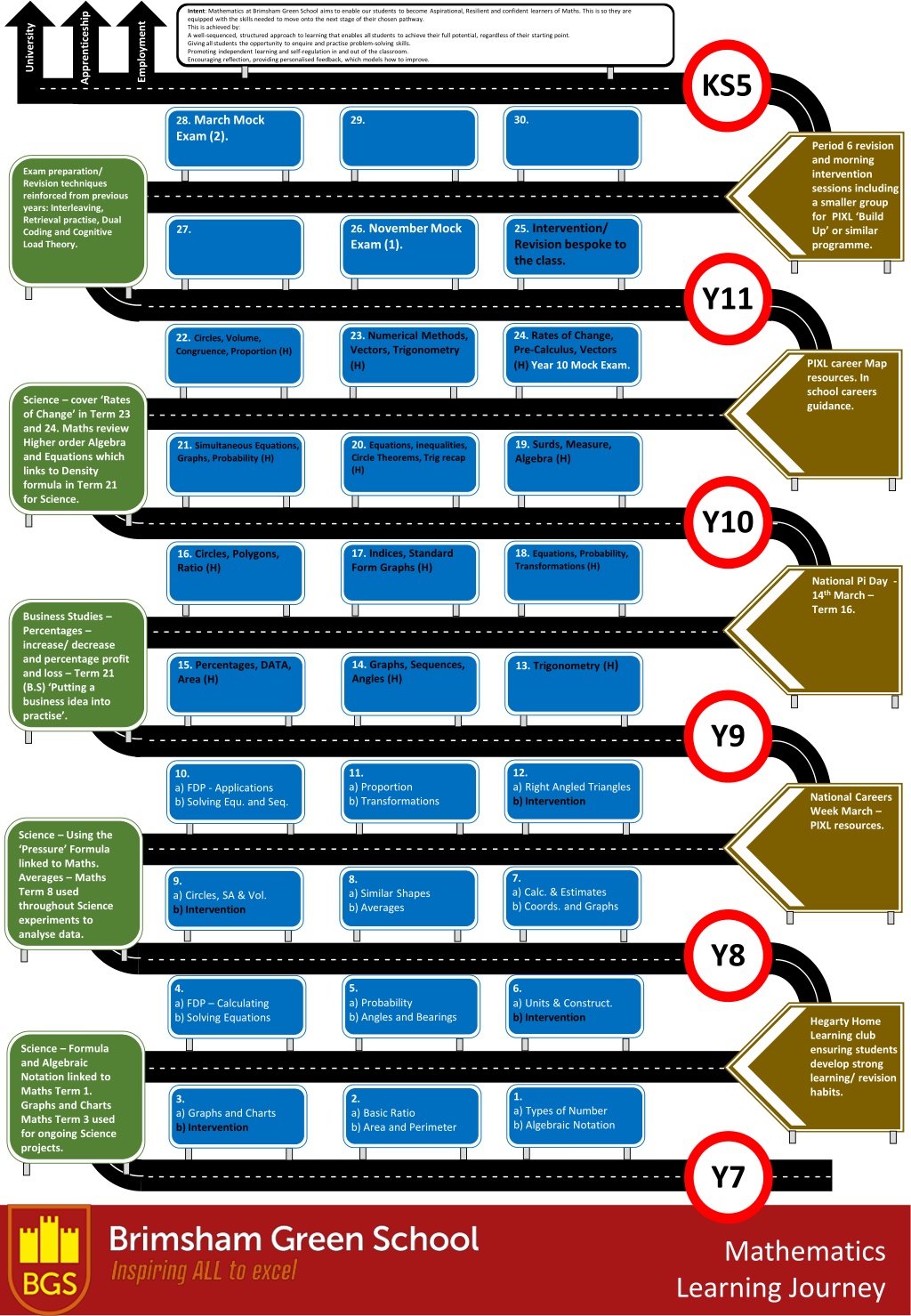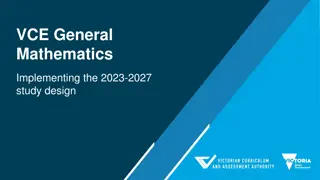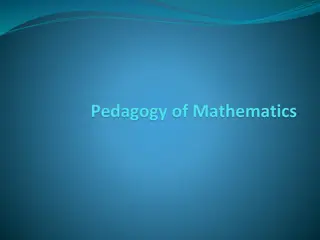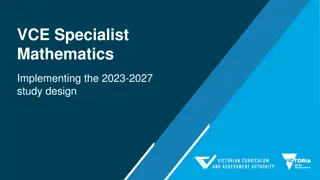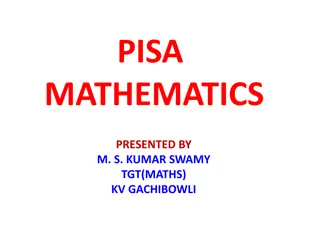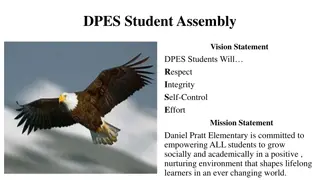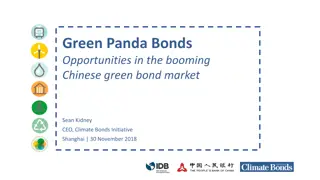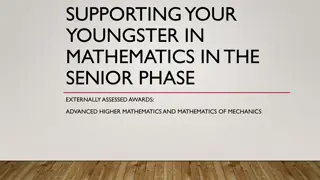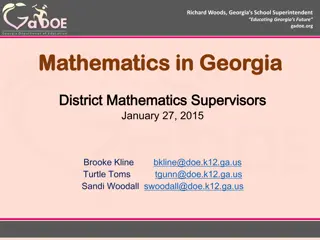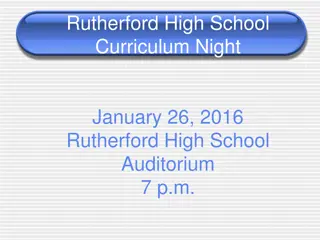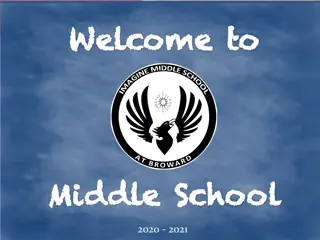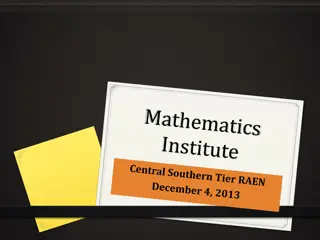Empowering Students Through Mathematics at Brimsham Green School
Mathematics at Brimsham Green School focuses on developing aspirational, resilient, and confident learners, providing them with essential skills for their future pathways. The curriculum is designed to nurture students' mathematical abilities, preparing them for success in their academic and personal endeavors.
Download Presentation

Please find below an Image/Link to download the presentation.
The content on the website is provided AS IS for your information and personal use only. It may not be sold, licensed, or shared on other websites without obtaining consent from the author. Download presentation by click this link. If you encounter any issues during the download, it is possible that the publisher has removed the file from their server.
E N D
Presentation Transcript
Intent: Mathematics at Brimsham Green School aims to enable our students to become Aspirational, Resilient and confident learners of Maths. This is so they are equipped with the skills needed to move onto the next stage of their chosen pathway. This is achieved by: A well-sequenced, structured approach to learning that enables all students to achieve their full potential, regardless of their starting point. Giving all students the opportunity to enquire and practise problem-solving skills. Promoting independent learning and self-regulation in and out of the classroom. Encouraging reflection, providing personalised feedback, which models how to improve. Apprenticeship Employment University KS5 - - - - - - - - - - - - - - - - - - - - - - - - - - - - - - - - - - - - - - - - - - - - - - - - - - - - - - - - - - - 30. 29. 28. March Mock Exam (2). Period 6 revision and morning intervention sessions including a smaller group for PIXL Build Up or similar programme. Exam preparation/ Revision techniques reinforced from previous years: Interleaving, Retrieval practise, Dual Coding and Cognitive Load Theory. - - - - - - - - - - - - - - - - - - - - - - - - - - - - - - - - - - - - - - - - - - - - - - - - - - - - - - - - - - 25. Intervention/ Revision bespoke to the class. 25. Intervention/ Revision bespoke to the class. 26. November Mock Exam (1). 27. Y11 - - - - - - - - - - - - - - - - - - - - - - - - - - - - - - - - - - - - - - - - - - - - - - - - - - - - - - - - - - 24. Rates of Change, Pre-Calculus, Vectors (H)Year 10 Mock Exam. 23. Numerical Methods, Vectors, Trigonometry (H) 22.Circles, Volume, Congruence, Proportion (H) PIXL career Map resources. In school careers guidance. Science cover Rates of Change in Term 23 and 24. Maths review Higher order Algebra and Equations which links to Density formula in Term 21 for Science. - - - - - - - - - - - - - - - - - - - - - - - - - - - - - - - - - - - - - - - - - - - - - - - - - - - - - - - - - - 19. Surds, Measure, Algebra (H) 20. Equations, inequalities, Circle Theorems, Trig recap (H) 21. Simultaneous Equations, Graphs, Probability (H) Y10 - - - - - - - - - - - - - - - - - - - - - - - - - - - - - - - - - - - - - - - - - - - - - - - - - - - - - - - - - - - 18. Equations, Probability, Transformations (H) 17. Indices, Standard Form Graphs (H) 16. Circles, Polygons, Ratio (H) National Pi Day - 14th March Term 16. Business Studies Percentages increase/ decrease and percentage profit and loss Term 21 (B.S) Putting a business idea into practise . - - - - - - - - - - - - - - - - - - - - - - - - - - - - - - - - - - - - - - - - - - - - - - - - - - - - - - - - - - 13. Trigonometry (H) 14. Graphs, Sequences, Angles (H) 15. Percentages, DATA, Area (H) Y9 - - - - - - - - - - - - - - - - - - - - - - - - - - - - - - - - - - - - - - - - - - - - - - - - - - - - - - - - - - 11. Proportion Transformations 12. Right Angled Triangles Intervention 10. FDP - Applications Solving Equ. and Seq. 12. a) Right Angled Triangles b)Intervention 11. a) Proportion b) Transformations 10. a) FDP - Applications b) Solving Equ. and Seq. National Careers Week March PIXL resources. Science Using the Pressure Formula linked to Maths. Averages Maths Term 8 used throughout Science experiments to analyse data. - - - - - - - - - - - - - - - - - - - - - - - - - - - - - - - - - - - - - - - - - - - - - - - - - - - - - - - - - - - 7. Calc. Estimates Coords. and Graphs 8. Similar Shapes Averages 9. Circles, SA Vol. Intervention 7. a) Calc. & Estimates b) Coords. and Graphs 8. a) Similar Shapes b) Averages 9. a) Circles, SA & Vol. b)Intervention Y8 - - - - - - - - - - - - - - - - - - - - - - - - - - - - - - - - - - - - - - - - - - - - - - - - - - - - - - - - - - 5. Probability Angles and Bearings 6. Units Construct. Intervention 4. FDP Calculating Solving Equations 5. a) Probability b) Angles and Bearings 6. a) Units & Construct. b)Intervention 4. a) FDP Calculating b) Solving Equations Hegarty Home Learning club ensuring students develop strong learning/ revision habits. Science Formula and Algebraic Notation linked to Maths Term 1. Graphs and Charts Maths Term 3 used for ongoing Science projects. - - - - - - - - - - - - - - - - - - - - - - - - - - - - - - - - - - - - - - - - - - - - - - - - - - - - - - - - - - 1. Types of Number Algebraic Notation 2. Basic Ratio Area and Perimeter 3. Graphs and Charts Intervention 1. a) Types of Number b) Algebraic Notation 2. a) Basic Ratio b) Area and Perimeter 3. a) Graphs and Charts b)Intervention Y7 - - - - - - - - - - - - - - - - - - - - - - - - - - - - - - - - - - - - - - - - - - - - - - - - - - - - - - - - - - - - - - - - Mathematics Learning Journey
Subject: Maths Topic: Factors, Multiples, Primes and Negatives Term: 1 Topic Intent: I will learn how to find factors and multiples. I will then explore how I can find common factors, highest common factors, common multiples and lowest common multiples. I will also explore prime numbers and their applications. I will begin to explore powers and roots and appreciate negative numbers. Key Knowledge: Know and understand the following words: (In the context of the Factors, Multiples, Primes and Negatives topic) - Multiple - Factor - Highest common factor - Lowest common multiple - Prime - Negative - Square number - Square root - Triangular number - Prime factor - Product - Cube number - Cube root Key Skills: Click to Return to Maths Learning Journey Click to Return to Maths Humanities / History Learning Journey
Subject: Maths Topic: Algebraic Notation and Manipulation Term: 1 Topic Intent: I will learn how to find write algebraic expressions and simplify them. I will begin to represent worded questions using algebra and manipulate these, such as by expanding or factorising a bracket. I will substitute numbers into an expression to evaluate the expression. Key Knowledge: Know and understand the following words: (In the context of the Algebraic Notation and Manipulation topic) - Algebra - Expression - Inverse - Substitute - Terms - Bracket - Multiply out - Factorise - Simplify - Index notation - Coefficient - Variable - Represent - Evaluate Key Skills: Click to Return to Maths Learning Journey Click to Return to Maths Humanities / History Learning Journey
Subject: Maths Topic: Basic Ratio Term: 2 Topic Intent: I will learn how to write a ratio from given information. I will then learn how to simplify ratios and find equivalent ratios important for scaling. I will begin to learn about proportion and will understand how this describes how 2 or more things are linked. I will learn that ratios can also be written as fractions and percentages. Key Knowledge: Know and understand the following words: (In the context of the Basic Ratio topic) - Ratio - Proportion - Part - Simplify - Equivalent - Common factor - Cancel - Lowest term - Unit - Multiplier - Unitary method - Convert Key Skills: Click to Return to Maths Learning Journey Click to Return to Maths Humanities / History Learning Journey
Subject: Maths Topic: Area and Perimeter Term: 2 Topic Intent: I will learn how to find the area and perimeter of common 2D shapes, by counting squares and learning the formulas. I will appreciate where these formulas have come from and begin to be able to work backwards to find missing lengths, if I am given the area. Key Knowledge: Know and understand the following words: (In the context of the Area and Perimeter topic) - Perimeter - Area - Square - Rectangle - Triangle - Parallelogram - Trapezium - Estimate - Compound - Prism - Surface area - Formula - Formulae - Length, breadth, depth, height, width - Squared unit Key Skills: Click to Return to Maths Learning Journey Click to Return to Maths Humanities / History Learning Journey
Subject: Maths Topic: Graphs and Charts Term: 3 Topic Intent: I will learn how data and can be represented in different ways. I will appreciate the differences in what these different representations look like and the key features of each of them. I will appreciate that as the same data can be presented in different ways, some methods of presentation can be better than others. Key Knowledge: Know and understand the following words: (In the context of the Graphs and Charts topic) - Data - Pictogram - Symbol - Key - Frequency - Table - Frequency table - Tally - Bar chart - Questionnaire - Scatter graph - Venn diagram - Two-way table - Interpret - Correlation - Line of best fit - Predict - Pie chart - Freq. polygon - Cumulative freq. Key Skills: Click to Return to Maths Learning Journey Click to Return to Maths Humanities / History Learning Journey
Subject: Maths Topic: Assessment Review and Intervention Term: 3 Topic Intent: Bespoke revision, review and intervention based on Assessment 1. Key Knowledge: Bespoke revision, review and intervention based on Assessment 1. Key Skills: Bespoke revision, review and intervention based on Assessment 1. Click to Return to Maths Learning Journey Click to Return to Maths Humanities / History Learning Journey
Subject: Maths Topic: Fractions, Decimals, Percentages - Calculating Term: 4 Topic Intent: I will learn that fractions, decimals and percentages can all be used to represent the same quantity. I will begin to be able to convert between all 3 of these. I will learn the skills needed to be able to calculate with these and embed my skills of being able to simplify fractions and find equivalent fractions. Key Knowledge: Know and understand the following words: (In the context of the Fractions, Decimals, Percentages - Calculating topic) - Fraction - Decimal - Percentage - Equivalent - Like fraction - Non-unit fraction - Improper fraction - Mixed number - Unlike fraction - Recurring decimal Key Skills: Click to Return to Maths Learning Journey Click to Return to Maths Humanities / History Learning Journey
Subject: Maths Topic: Solving Equations Term: 4 Topic Intent: I will learn what an equation is and that equations can be solved, to find answers . I will learn the skills needed to solve linear equations. I will look at problems in context so I can see where equations can appear in real life . I will begin to use my abilities to manipulate algebra to look at more complex equations. Key Knowledge: Know and understand the following words: (In the context of the Solving Equations topic) - Algebra - Equation - 1 step and 2 step - Formulae - Inverse - Substitute - Terms - Bracket - Multiply out - Factorise - Simplify - Unknown - Square - Square root - Quadratic Key Skills: Click to Return to Maths Learning Journey Click to Return to Maths Humanities / History Learning Journey
Subject: Maths Topic: Probability Term: 5 Topic Intent: I will begin to understand what probability means and how words can be used to describe how likely something is to happen. I will then begin to look at using numbers and values to define probabilities and consider the outcomes of random experiments. Key Knowledge: Know and understand the following words: (In the context of the Probability topic) - Probability - Scale - Likelihood - Outcome - Experiment - Mutually exclusive - Equally likely - Experimental - Theoretical - Expected outcome - Two-way table - Systematically - Venn diagram - Relative frequency - Independent Key Skills: Click to Return to Maths Learning Journey Click to Return to Maths Humanities / History Learning Journey
Subject: Maths Topic: Angles and Bearings Term: 5 Topic Intent: I will learn what an angle is and how they can be measured. I will understand that sketches of angle diagrams are not accurate and therefore I cannot just measure them with a protractor. I will learn basic angle facts that will help me solve these problems. I will begin to extend this to angles on parallel lines and bearings. Key Knowledge: Know and understand the following words: (In the context of the Angles and Bearings topic) - Angle - Measure - Protractor - Compass - Direction - Polygon - Bearing - Quadrilateral - Triangle - Isosceles - Equilateral - Parallelogram - Rhombus - Alternate, Corresponding, Interior - Regular - Proof Key Skills: Click to Return to Maths Learning Journey Click to Return to Maths Humanities / History Learning Journey
Subject: Maths Topic: Units, Constructions and 3D Representations Term: 6 Topic Intent: I will learn to identify common 3D shapes and learn their properties. I will learn how these shapes can be represented on isometric paper. I will learn that measurement can be measured in different units and appreciate the most suitable unit to measure a certain item in. I will begin to covert these units. I will begin to create constructions and scale drawings. Key Knowledge: Know and understand the following words: (In the context of the Units, Constructions and 3D Representations topic) - Digital clock - Vertice/Vertex - Edges - Faces - 3D shape - Measure - Elevation - Isometric - Nets - Timetables - Perpendicular - Bisector - Loci - Units - Compound Key Skills: Click to Return to Maths Learning Journey Click to Return to Maths Humanities / History Learning Journey
Subject: Maths Topic: Assessment Review and Intervention Term: 6 Topic Intent: Bespoke revision, review and intervention based on Assessment 2. Key Knowledge: Bespoke revision, review and intervention based on Assessment 2. Key Skills: Bespoke revision, review and intervention based on Assessment 2. Click to Return to Maths Learning Journey Click to Return to Maths Humanities / History Learning Journey
Subject: Maths Topic: Calculations and Estimates Term: 7 Topic Intent: I will review how to use the 4 operations with integers and decimals. I will consider the order that operations need to be completed in. I will learn that rounding can be used to approximate an answer, to different degrees of accuracy. I will also appreciate that rounding can be used to approximate an answer to a calculation. Key Knowledge: Know and understand the following words: (In the context of the Calculations and Estimates topic) - Integer - Round - Rounding - Inequality - Decimal place - BIDMAS - Significant figure - Inverse - Estimate - Interpret - Approximation - Bounds Key Skills: Click to Return to Maths Learning Journey Click to Return to Maths Humanities / History Learning Journey
Subject: Maths Topic: Coordinates and Graphs Term: 7 Topic Intent: I will review how to read and plot coordinates on a grid. I will extend this understanding to look at the equations of lines horizontal, vertical and diagonal. I will begin to look at the key features of straight line graphs and consider the graphs of quadratic, cubic and reciprocal functions. Key Knowledge: Know and understand the following words: (In the context of the Coordinates and Graphs topic) - Axes - Coordinate - Horizontal - Vertical - Table of values - Y=mx+c - Linear - Gradient - Y intercept - Quadratic - Cubic - Reciprocal - Function - Parallel - Perpendicular Key Skills: Click to Return to Maths Learning Journey Click to Return to Maths Humanities / History Learning Journey
Subject: Maths Topic: Similar Shapes Term: 8 Topic Intent: I will review how to write information as a ratio. I will then learn how to use ratios to find missing parts and quantities. I will learn that 2 shapes are similar if they are in the same proportion. I will then find the missing lengths of similar shapes and begin to consider how this relationship works with area and volume. Key Knowledge: Know and understand the following words: (In the context of the Similar Shapes topic) - Ratio - Scale factor - Scale diagram - Simplify - Integer - Similar shape - Congruent - Proportion Key Skills: Click to Return to Maths Learning Journey Click to Return to Maths Humanities / History Learning Journey
Subject: Maths Topic: Averages Term: 8 Topic Intent: I will learn the names of the 3 types of average and appreciate that the range is used to describe the spread of the data. I will begin to appreciate that each average may give a different answer and consider which average is best used to represent a set of data. I will begin to look at obtaining averages from graphs and charts. Key Knowledge: Know and understand the following words: (In the context of the Averages topic) - Mode - Median - Mean - Range - Average - Data - Modal - Grouped data - Frequency table - Quartiles - Interquartile range - Discrete - Continuous Key Skills: Click to Return to Maths Learning Journey Click to Return to Maths Humanities / History Learning Journey
Subject: Maths Topic: Circles, Surface Area and Volume Term: 9 Topic Intent: I will learn the names of the parts of a circle and know that there are formulas for finding the circumference and area of a circle. I will begin to consider questions that require multiple steps, involve working backwards or involve compound shapes. Key Knowledge: Know and understand the following words: (In the context of the Circles, Surface Area and Volume topic) - Surface Area - Cuboid - Net - Radius - Diameter - Chord - Tangent - Sector - Segment - Circumference - Prism - Semi/quarter circle - Arc length - Sector - Cone - Cylinder - Sphere Key Skills: Click to Return to Maths Learning Journey Click to Return to Maths Humanities / History Learning Journey
Subject: Maths Topic: Assessment Review and Intervention Term: 9 Topic Intent: Bespoke revision, review and intervention based on Assessment 1. Key Knowledge: Bespoke revision, review and intervention based on Assessment 1. Key Skills: Bespoke revision, review and intervention based on Assessment 1. Click to Return to Maths Learning Journey Click to Return to Maths Humanities / History Learning Journey
Subject: Maths Topic: Fractions, Decimals, Percentages - Applications Term: 10 Topic Intent: I will apply my knowledge of how to calculate with fractions, decimals and percentages to look at applied questions. I will learn how to find percentages and fractions of an amount and learn how to find a percentage change using multipliers. Key Knowledge: Know and understand the following words: (In the context of the Fractions, Decimals, Percentages - Applications topic) - Percentage - Equivalent - Fraction - Decimal - Tenths, hundredths - Unit fraction - Multiplier - Improper fraction - Compound interest Key Skills: Click to Return to Maths Learning Journey Click to Return to Maths Humanities / History Learning Journey
Subject: Maths Topic: Solving Harder Equations and Sequences Term: 10 Topic Intent: I will review how to solve linear equations and begin to use algebraic skills to form equations from problems in context. I will begin to look at other types of equation, involving quadratics. I will learn that sequences always follow a pattern and investigate term to term and position to term rules. Key Knowledge: Know and understand the following words: (In the context of the Solving Harder Equations and Sequences topic) - Sequence - Term to term rule - Arithmetic sequence - Equation - Formulae - Geometric sequence - Expression - Nth term - Identity - Quadratic sequence - Subject of a formula - Factorise - Index rules - Algebraic fraction - Simultaneous equation Key Skills: Click to Return to Maths Learning Journey Click to Return to Maths Humanities / History Learning Journey
Subject: Maths Topic: Proportion (Direct and Inverse) Term: 11 Topic Intent: I will use my knowledge of ratios to consider proportion problems. I will learn that there are 2 types of proportion direct and inverse. I will learn how to solve direct and inverse problems multiplicatively and identify from worded problems when a situation is describing direct or inverse proportion. Key Knowledge: Know and understand the following words: (In the context of the Direct and Inverse Proportion topic) - Ratio - Equivalent ratio - Simplify ratio - Integer - Scale diagrams - Multiplier - Similar shape - Proportion - Direct proportion - Inverse proportion Key Skills: Click to Return to Maths Learning Journey Click to Return to Maths Humanities / History Learning Journey
Subject: Maths Topic: Transformations Term: 11 Topic Intent: I will learn there are 4 types of transformation and will begin to learn the main features and outcomes of each. I will explore the themes of symmetry, measurement and shape properties. I will begin to explore multi-step transformations and work backwards to identify which transformation has taken place, given an object and an image. Key Knowledge: Know and understand the following words: (In the context of the Transformations topic) - Transformation - Symmetry - Horizontal - Vertical - Reflection - Rotation - Vertex - Mirror line - Congruent - Enlargement - Translation - Centre of rotation - Vector - Preserves - Invariant Key Skills: Click to Return to Maths Learning Journey Click to Return to Maths Humanities / History Learning Journey
Subject: Maths Topic: Right Angled Triangles Term: 12 Topic Intent: I will learn the mathematical name for the longest side of a right angles triangle. I will learn that there is a formula for finding the missing side of a right angled triangle. I will begin to apply this to worded and applied problems. I will begin to understand that there are other ways of finding missing sides in triangles, when gives angles. Key Knowledge: Know and understand the following words: (In the context of the Right Angled Triangles topic) - Right angle - Triangle - Square number - Square root - Hypotenuse - Theorem - Pythagoras - SOHCAHTOA - Trig ratio Key Skills: Click to Return to Maths Learning Journey Click to Return to Maths Humanities / History Learning Journey
Subject: Maths Topic: Assessment Review and Intervention Term: 12 Topic Intent: Bespoke revision, review and intervention based on Assessment 2. Key Knowledge: Bespoke revision, review and intervention based on Assessment 2. Key Skills: Bespoke revision, review and intervention based on Assessment 2. Click to Return to Maths Learning Journey Click to Return to Maths Humanities / History Learning Journey
Subject: Mathematics Topic: Trigonometry Higher Tier Term: 13 Topic Intent: 1. Explore the uses of Trigonometry within triangles. 2. Extend knowledge of Rounding to truncation and limits of accuracy. 3. Expand Algebra knowledge from linear to Quadratic. Misconceptions: Some students may use Pythagoras theorem as though the missing side is always the hypotenuse Key Knowledge: 1. Know the difference between decimal places and significant figures. 2. Know how to manipulate algebraic expressions including linear and Quadratic 3. Know the Formula for Pythagoras Theorem and the Trigonometric ratios 4. Know the four operations with decimals and Fractions Key Skills: Pythagoras Theorem and basic Trigonometry Know the formula for Pythagoras' Theorem a2+b2=c2 Apply it to find angles and lengths in right angled triangles and, where possible, general triangles in two and three dimensional figures Know and use the trigonometric ratios ???????? ????????? c??? = ???????? ????????????? = ???????? ????????? ???? = Apply angle facts, triangle congruence, similarity and properties of quadrilaterals to conjecture and derive results about angles and sides including Pythagoras Theorem and use known results to obtain simple proofs Compare lengths using ratio notation; make links to trigonometric ratios Click to Return to Maths Learning Journey Click to Return to Maths Humanities / History Learning Journey
Subject: Mathematics Topic: Graphs, Sequences and Angles Higher Tier Term: 14 Topic Intent: 1. Develop line graphs beyond y = mx + c to involve intercepts and graphical representation. 2. Expand and recap on basic angle rules to include Circle Theorems. 3. Progress from Linear Sequences to Quadratic Sequences. Key Knowledge: 1. Know the terms and definitions associated with y = mx + c. 2. Know how to identify parallel and perpendicular lines. 3. Know all basic Angle rules including those within parallel lines. 4. Know the requirements for linear, Quadratic and special sequences. Misconceptions: Some pupils may think that alternate and/or corresponding angles have a total of 180 rather than being equal. Some pupils may think that the sum of the interior angles of an n-sided polygon can be calculated using Sum = n 180 . Some pupils may think that the sum of the exterior angles increases as the number of sides of the polygon increases. Key Skills: Coordinates and line graphs Plot graphs of equations of straight lines Identify parallel and perpendicular lines using y = mx + c Find equation of line through 2 points or one point with given gradient Intercepts and gradients graphically and algebraically Use angle properties with straight lines, round point, in triangles, parallel lines with correct vocabulary- not f, c and z Use and find scale factors Draw scale diagrams Interpret maps Use compass points and three figure bearings measure and draw Generate sequences form rules, patterns and diagrams Know special sequences including Fibonacci type Simple arithmetic and geometric progressions Quadratic sequences and other sequences Find nth term of linear and quadratic sequences Angles, scale diagrams & bearings Sequences Click to Return to Maths Learning Journey Click to Return to Maths Humanities / History Learning Journey
Subject: Mathematics Topic: Percentages, Data and Area Higher Tier Term: 15 Topic Intent: 1. Review Basic Percentages. 2. Expand on Collecting and Representing data to more complex charts such as Histograms and Cumulative Frequency Graphs. 3. Recap basic Area and Perimeter leading onto Surface Area and Volume. Key Knowledge: 1. Know and identify different types of data. 2. Know formula for areas of different shapes. Key Skills: Basic percentages Express one quantity as a percentage of another Compare using percentages Work with percentages > 100 Interpret % & %change as fractions & decimals & interpret multiplicatively Interpret fraction & percentage as operators Interpret and construct frequency tables, bar charts, pie charts, pictograms, vertical line charts, time series data Know and identify different types of data: primary, secondary, discrete, continuous, etc. AVERAGES Choosing most suitable diagrams Compare distributions of different types of data including using box plots Histograms & cumulative frequency graphs equal & unequal intervals Properties of 3D shapes Perimeter of 2D shapes and composite shapes Surface area of pyramids composite shapes Areas of triangles, parallelograms, trapezia Collecting and representing data Perimeter & area Click to Return to Maths Learning Journey Click to Return to Maths Humanities / History Learning Journey
Subject: Mathematics Topic: Circles, Polygons, Ratio Higher Tier Term: 16 Topic Intent: 1. Expand existing area and perimeter knowledge to include circles. 2. Develop basic angle knowledge further by introducing angles within polygons. 3. Link fraction usage to ratio and incorporate real life scenarios. Key Knowledge: 1. Know Circle Definitions for tangent, arc, sector and segment. 2. Know formula for arc length and area of sector. 3. Know formula for interior and exterior angles in regular polygons. 4. Recognise and know properties of all quadrilaterals and all types of triangle. Key Skills: Circumference and area Circle definitions including tangent, arc, sector, segment Area & circumference including composite shapes and in terms of pi Surface area of spheres, cones, composite solids Arc lengths, angles & areas of sectors Use sum of angles in triangles and deduce sum of angles in polygons. Names & properties of polygons and regular polygons Derive and apply properties of special quadrilaterals and triangles Use ratio notation, identify & work with fractions in ratio problems Express one quantity as a fraction of another Divide a quantity into a ratio including best buy type problems Express division of a quantity into two parts as a ratio Apply ratio to real contexts e.g. conversion, scaling, mixing, comparison Express multiplicative relationship between two quantities as ratio or fraction Understand and use proportion as equality of ratios Relate ratios to fractions and to linear functions Properties of polygons Ratio & proportion Click to Return to Maths Learning Journey Click to Return to Maths Humanities / History Learning Journey
Subject: Mathematics Topic: Indices, Standard Form, Graphs Higher Tier Term: 17 Topic Intent: 1. Develop knowledge of indices. 2. Work with numbers beyond our thought process by using standard form. 3. Expand graph knowledge beyond linear and Quadratic into the realms of cubic, exponential, reciprocal and link to real life scenarios. Key Knowledge: 1. Know square numbers up to 15. 2. Know cube numbers 1,2,3,4,5,10. 3. Know powers of ten and use within standard form. 4. Recognise non-standard graphs including reciprocal and exponential. Key Skills: Indices Use positive integer powers and associated real roots Know square numbers up to 15 Recognise powers of 2,3,4,5 Estimate powers and roots of any given positive number Calculate with roots and with integer and fractional indices Understand and use place value with very large and very small numbers. Calculate with and interpret standard form with and without a calculator. Plot & interpret graphs (including reciprocal & exponential) & graphs of non standard functions to find approximate solutions to simple problems e.g. kinematic problems involving distance, speed, acceleration. Interpret gradient of straight line graphs as a rate of change. Use and interpret scatter graphs of bivariate data Recognise correlation and know that it does not indicate causation Draw estimated lines of best fit Make predictions Interpolate and extrapolate apparent trends whilst knowing the dangers of doing so know and understand the terms positive correlation, negative correlation, no correlation, weak correlation and strong correlation Standard form Real life graphs & Scattergraphs Click to Return to Maths Learning Journey Click to Return to Maths Humanities / History Learning Journey
Topic: Equations, Transformations, Probability Higher Tier Subject: Mathematics Term: 18 Topic Intent: 1. Recap solving linear equations. 2. Expand on Probability knowledge to more than one event. This will then give more practical uses in the real world. 3. Recap Transformations and introduce Invariance. Key Knowledge: 1. Know the difference between formulae and expressions. 2. Know the sum of all probabilities is 1. 3. Know the different types of Transformations. Key Skills: Equations Substitution into formulae and expressions Solve linear equations including brackets on both sides Frequency of outcomes of probability experiments using tables and frequency trees in fraction, decimal and percentage form. Use sum of probabilities of all outcomes and mutually exclusive events is 1. Construct possibility spaces and use to calculate theoretical probabilities. Basic probability Identify, describe and construct congruent and similar shapes, including on co-ordinate axes, by considering rotation, reflection, translation and enlargement (including fractional and negative scale factors) Describe translations as 2D vectors Describe the changes and invariance achieved by combinations of rotations, reflections and translations Transformations Click to Return to Maths Learning Journey Click to Return to Maths Humanities / History Learning Journey
Subject: Mathematics Topic: Surds, Measure, Algebra Higher Tier Term: 19 Topic Intent: 1. Introduce SURDS and how to manipulate them, linking the topic to square number knowledge. 2. Recap Standard Measures. 3. Recap LOCI and its uses. 4. Expand on Function knowledge to include composite Functions, Inverse functions and function notation. Key Knowledge: 1. Recognise and use simple geometric progressions. 2. Know metric conversion factors imperial/metric conversions given in questions. 3. Know that the perpendicular distance from a point to a line is the shortest distance to the line. 4. Know the difference between an equation and an identity. Key Skills: Surds Calculate exactly with surds Simplify surd expressions and rationalise denominators Recognise and use simple geometric progressions (rn where n is an integer and r is a surd) Use standard units of measure including compound measures Use compound units such as speed, rates of pay, unit pricing, density and pressure. Change between related standard units and compound units in numerical and algebraic contexts. Apply and interpret limits of accuracy including upper and lower bounds. Use the standard ruler and compass constructions: perpendicular bisector of a line segment constructing a perpendicular to a given line from / at a given point bisecting a given angle Use these to construct given figures and solve loci problems Simplify and manipulate algebraic expressions (including those involving surds) by: Measures 2D representation of 3D shapes Constructions & loci Algebra: Quadratics, rearranging formulae and identities, algebraic fractions Rearrange formulae to change the subject - Argue mathematically to show algebraic expressions are equivalent, and use algebra to support and construct arguments and proofs - Where appropriate, interpret simple expressions as functions with inputs and outputs - Interpret the reverse process as the inverse function - Interpret the succession of two functions as a composite function - understand and use function notation: f(x), fg(x), f 1(x) is expected at higher tier- Simplify and manipulate algebraic expressions involving algebraic fractions Click to Return to Maths Learning Journey Click to Return to Maths Humanities / History Learning Journey
Subject: Mathematics Topic: Equations, inequalities, Circle Theorems, Trig recap Higher Tier Term: 20 Topic Intent: 1. Explore different methods of solving Quadratic equations. 2. Represent Inequalities on a number line and graphically. 3. Expand on basic angle knowledge into Circle Theorems and introduce ideas of proof. Key Knowledge: 1. Know and be able to prove Circle Theorem rules: angle at centre is equal to twice angle at circumference; angle in a semi-circle is 90 ; angles in the same segment are equal; opposite angles in a cyclic quadrilateral sum to 180 ; tangent at any point on a circle is perpendicular to the radius at that point tangents from an external point are equal in length; the perpendicular from the centre to a chord bisects the chord; alternate segment theorem 2. Know and use Trigonometric ratios and exact values. Key Skills: Solve quadratic equations (including those that require rearrangement) algebraically by factorising, by completing the square and by using the quadratic formula Further equations and graphs Find approximate solutions using a graph Identify and interpret roots, intercepts and turning points of quadratic functions graphically; deduce roots algebraically and turning points by completing the square. Including symmetrical property of quadratics Translate simple situations or procedures into algebraic expressions or formulae derive an equation, solve the equation and interpret the solution including solution of geometrical problems and problems set in context Inequalities Solve linear inequalities in one or two variables and quadratic inequalities in one variable Represent the solution set on a number line, using set notation and on a graph know the conventions of an open circle on a number line for a strict inequality and a closed circle for an included boundary in graphical work the convention of a dashed line for strict inequalities and a solid line for an included inequality will be required Apply and prove the standard circle theorems concerning angles, radii, tangents and chords and prove them. Circle theorems Click to Return to Maths Learning Journey Click to Return to Maths Humanities / History Learning Journey
Subject: Mathematics Topic: Simultaneous Equations, Graphs, Probability Higher Tier Term: 21 Topic Intent: 1. Solve linear and Quadratic Equations Simultaneously having two unknowns. 2. Sketch more advanced graph work including Trigonometric functions. 3. Apply knowledge of Probability and Tree diagrams to solve problems. Key Knowledge: 1. Recognise, sketch and interpret graphs of linear functions, quadratic functions, simple cubic functions and the reciprocal function with exponential functions for positive values and the trigonometric functions (with arguments in degrees) for angles of any size. 2. Understand that empirical unbiased samples tend towards theoretical probability distributions with increasing sample size. Key Skills: Simultaneous equations Solve two simultaneous equations in two variables (linear / linear or linear/quadratic) algebraically Find approximate solutions using a graph Translate simple situations or procedures into algebraic expressions or formulae Derive two simultaneous equations Solve the equations and interpret the solution including the solution of geometrical problems and problems set in context Apply ideas of randomness, fairness and equally likely events to calculate expected outcomes or multiple future experiments Relate relative expected frequencies to theoretical probability, using appropriate language and the 0 1 probability scale Enumerate sets and combinations of sets systematically, using tables, grids, Venn diagrams and tree diagrams Calculate the probability of independent and dependent combined events, including using tree diagrams and other representations, and know the underlying assumptions ie know when to add and when to multiply two or more probabilities. Calculate and interpret conditional probabilities through representation using expected frequencies with two-way tables, tree diagrams and Venn diagrams Probability Tree diagrams should have been used in Yr 10 term 5 focus on application to solve problems here. Click to Return to Maths Learning Journey Click to Return to Maths Humanities / History Learning Journey
Subject: Mathematics Topic: Circles, Volume, Congruence, Proportion Higher Tier Term: 22 Topic Intent: 1. Expand Solving Equation knowledge to Equations of Circles. 2. Explore Volume of more complex shapes e.g spheres, frustra. 3. Be able to categorise types of congruency within Triangles. 4. Use similarity to solve missing value problems. 5. Introduce Direct and Inverse proportion as an extension to proportionality. Key Knowledge: 1. Know the generic equation for a circle. 2. Know the criteria for congruency within triangles. 3. Recognise graphically the difference between Inverse and Direct proportion. Key Skills: Equation of a circle Recognise and use the equation of a circle with centre at the origin Find the equation of a tangent to a circle at a given point. Compare lengths, areas and volumes using ratio notation Scale factors Make links to similarity Calculate the volume of spheres, pyramids, cones and composite solids including frustra. Calculate exactly with multiples of Use basic congruence criteria for triangles SSS, SAS, ASA,RHS Apply angle facts, triangle & quadrilateral properties to conjecture and derive results about angles and use known results to obtain simple proofs Apply and use congruence and similarity, including relationships between lengths areas & volumes in similar figures. Solve problems involving direct and inverse proportion, including graphical and algebraic representations Understand that X is inversely proportional to Y is equivalent to X is proportional to 1 Volume (cuboids and prisms should have been met in Yr 10) Congruence & similarity Direct and Inverse Proportion ? Construct and interpret equations that describe direct and inverse proportion Recognise and interpret graphs that illustrate direct and inverse proportion Click to Return to Maths Learning Journey Click to Return to Maths Humanities / History Learning Journey
Subject: Mathematics Topic: Numerical Methods, Vectors, Trigonometry Higher Tier Term: 23 Topic Intent: 1. First look at iteration based on the principle of repeated substitution. 2. Recap Vectors from Transformations and expand into Vector Geometry. 3. Further explore Trigonometry with the SINE and COSINE Rules. Key Knowledge: 1. Know the use of suffix notation in recursive formulae. 2. Know the laws of Vector Geometry for addition, subtraction and multiplication. 3. Know the Sine and Cosine rules as well as the formula for a non-right angle triangle using the Sine function. Key Skills: Find approximate solutions to equations numerically using iteration including the use of suffix notation in recursive formulae Numerical Methods Apply addition and subtraction of vectors, multiplication of vectors by a scalar, and diagrammatic and column representation of vectors Use vectors to construct geometric arguments and proofs Sketch translations and reflections of a given function Vectors Transforming functions Sine and Cosine rules Know and apply the Sine rule and Cosine rule to find unknown lengths and angles Know and apply to calculate the area, sides or angles of any triangle Click to Return to Maths Learning Journey Click to Return to Maths Humanities / History Learning Journey
Subject: Mathematics Topic: Rates of Change, Pre-Calculus, Vectors Higher Tier Term: 24 Topic Intent: 1. Introduce graphical rates of change as a bridging topic which lead to A Level and differentiation. 2. Introduce connections between units on axis that result in a third product. 3. Link curved graphs to growth and decay (exponential) and also compound interest. 4. Recap Vectors and associated laws and rules of Vector Geometry. Key Knowledge: 1. Know how to find the Gradient of a straight line. 2. Know basic area formula of shapes : Triangle, Rectangle, Trapezium etc 3. Know the difference between a distant time graph and a velocity time graph and the key features on each. 4. Know the laws of Vector Geometry for addition, subtraction and multiplication. Key Skills: Gradients and Rates of Change Interpret the gradient of a straight-line graph as a rate of change Interpret the gradient at a point on a curve as the instantaneous rate of change Apply the concepts of average and instantaneous rates of change (gradients of chords and tangents) in numerical, algebraic and graphical contexts Calculate or estimate gradients of graphs and areas under graphs (including quadratic and other non-linear graphs) Pre-Calculus and Area under a Curve Interpret the results in cases such as distance-time graphs, velocity-time graphs and graphs in financial contexts Set up, solve and interpret the answers in growth and decay problems, including compound interest Growth and Decay Vectors Apply addition and subtraction of vectors, multiplication of vectors by a scalar, and diagrammatic and column representation of vectors Click to Return to Maths Learning Journey Click to Return to Maths Humanities / History Learning Journey
Subject: Mathematics Topic: Intervention/ Revision bespoke to the class Term: 25 Topic Intent: 1. At the end of Year 10 students would have sat an end of year exam. The QLA (Question level analysis) from this will inform teachers of a revision plan/ intervention programme bespoke to the students in front of them for the duration of Year 11. Key Knowledge: 1. xxx Key Skills: 1. xxx Click to Return to Maths Learning Journey Click to Return to Maths Humanities / History Learning Journey
Subject: xxx Topic: xxx Term: 26 Topic Intent: 1. xxx Key Knowledge: 1. xxx Key Skills: 1. xxx Click to Return to xxx Learning Journey Click to Return to xxx Humanities / History Learning Journey
Subject: xxx Topic: xxx Term: 27 Topic Intent: 1. xxx Key Knowledge: 1. xxx Key Skills: 1. xxx Click to Return to xxx Learning Journey Click to Return to xxx Humanities / History Learning Journey
Subject: xxx Topic: xxx Term: 28 Topic Intent: 1. xxx Key Knowledge: 1. xxx Key Skills: 1. xxx Click to Return to xxx Learning Journey Click to Return to xxx Humanities / History Learning Journey
Subject: xxx Topic: xxx Term: 29 Topic Intent: 1. xxx Key Knowledge: 1. xxx Key Skills: 1. xxx Click to Return to xxx Learning Journey Click to Return to xxx Humanities / History Learning Journey
Subject: xxx Topic: xxx Term: 30 Topic Intent: 1. xxx Key Knowledge: 1. xxx Key Skills: 1. xxx Click to Return to xxx Learning Journey Click to Return to xxx Humanities / History Learning Journey
